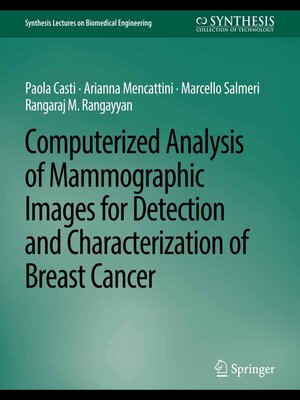Computerized Analysis of Mammographic Images for Detection and Characterization of Breast Cancer
ebook ∣ Synthesis Lectures on Biomedical Engineering
By Arianna Mencattini

Sign up to save your library
With an OverDrive account, you can save your favorite libraries for at-a-glance information about availability. Find out more about OverDrive accounts.
Find this title in Libby, the library reading app by OverDrive.



Search for a digital library with this title
Title found at these libraries:
| Library Name | Distance |
|---|---|
| Loading... |
The identification and interpretation of the signs of breast cancer in mammographic images from screening programs can be very difficult due to the subtle and diversified appearance of breast disease. This book presents new image processing and pattern recognition techniques for computer-aided detection and diagnosis of breast cancer in its various forms. The main goals are: (1) the identification of bilateral asymmetry as an early sign of breast disease which is not detectable by other existing approaches; and (2) the detection and classification of masses and regions of architectural distortion, as benign lesions or malignant tumors, in a unified framework that does not require accurate extraction of the contours of the lesions. The innovative aspects of the work include the design and validation of landmarking algorithms, automatic Tabár masking procedures, and various feature descriptors for quantification of similarity and for contour independent classification of mammographic lesions. Characterization of breast tissue patterns is achieved by means of multidirectional Gabor filters. For the classification tasks, pattern recognition strategies, including Fisher linear discriminant analysis, Bayesian classifiers, support vector machines, and neural networks are applied using automatic selection of features and cross-validation techniques. Computer-aided detection of bilateral asymmetry resulted in accuracy up to 0.94, with sensitivity and specificity of 1 and 0.88, respectively. Computer-aided diagnosis of automatically detected lesions provided sensitivity of detection of malignant tumors in the range of [0.70, 0.81] at a range of falsely detected tumors of [0.82, 3.47] per image. The techniques presented in this work are effective in detecting and characterizing various mammographic signs of breast disease.







